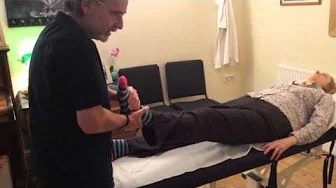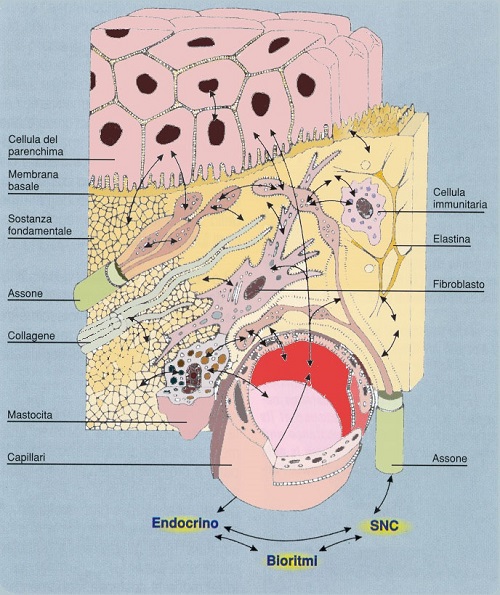Positive Health Online
Your Country

Stagnant!
by Jonathan Lawrence(more info)
listed in craniosacral therapy, originally published in issue 290 - November 2023
I was looking at my friend Kathryn (name changed but permission to share). She is late fifties and reasonably active, she dances and does yoga. I noticed slight swelling of the ankles and stiffness on moving. The word stagnation came into my mind.
I principally use cranial techniques in my osteopathic practice, but my feeling that something more mechanical was required. I suggested I give her a General Osteopathic Treatment (GOT) from the repertoire of Classical Technique.
This approach involves a routine of stretching and articulating tissues and joints throughout the body in a rhythmical fashion, diagnosing and treating imbalances.
With her, the initial emphasis of the treatment was stretching the ligaments of the feet and ankles as well as articulating the joints and the arches.
Secondly a series of lymph pumps[1] were performed which involves contacting the ankles, stretching the legs, then letting go. This pumping action stimulates the flow of lymph throughout the whole system as well as other fluids by altering the structure of water within those fluids.[2]
The rest of the treatment involved working through pelvis, spine, ribs, neck, and soft tissues, including those of the abdomen. The latter emphasising freeing the organs, encouraging blood and lymph flow in order to optimise function. The liver, colon, spleen and uterus can be treated pretty directly, other organs indirectly.

Fig 1 Lymph Pump
Following that one treatment Kathryn reported feeling straighter, less stiff and the slight but significant swelling of the ankles which she had experienced for years disappeared.
What is unique about this method is that all the movements are passive on behalf of the patient. She is not contracting any muscles or soft tissues.
This is illustrative of one of the three key principles of osteopathy as defined by the founder Andrew Taylor Still; ‘The Rule of the Artery is Supreme’. The others being: ‘Structure Governs Function’ and ‘The Body is a Self-Healing Mechanism.’
Kathryn’s experience with the treatment supports the importance of the principle that the flow of body fluids (Rule of the Artery) is key to the maintenance of health. This occurs through the delivery of nutrients and the disposal of toxins as well being part of the complex communications systems of the body.
So how and why we become stagnant? In the following section we can examine the key factors involved:
- Lack of Physical Movement. Obviously, anno domini takes its toll, but so too do the infringements of the modern world. This era has many benefits, however, as a general rule we spend so much time sitting down, whether in front of a computer or driving and much less time standing or doing physical work.
- Lack of Autonomic Nervous Stimulation: Our autonomic nervous system in some ways is less naturally stimulated than was designed and in some cases artificially over stimulated.
- Shallow Breathing: Our lungs are not emptied enough if we exercise sub optimally.
- Exposure to Toxins: Toxicity, whether from poor elimination, diet or environmental toxins play a part in stasis. Exogenous toxins are almost impossible to accurately quantify as they are invisible and, in some cases, not accurately evaluated as in the soup of EMFs to which we are exposed. This could well be the reason that there is a huge and underacknowledged or unnoticed increase in chronic illness.[3] Perhaps one of the reasons this is the case is that that there is huge investment in and economic interest in hiding the causes. As an example, Samsel and Seneff [4] propose a number of mechanisms by which the ubiquitous pesticide, glyphosate can contribute to disease, for example. Glyphosate is used in association with Roundup ready GMO crops and may be contributing to environmental degradation, depletion of soil quality and subsequent depletion of nutrients.
- Lack of Connection with Natural Rhythms: These include diurnal, lunar, seasonal and disturbance of our connection with the Schumann resonances[5] and the related earthing. [6]
- Sub-optimal Exposure to Light: This is related to the above. We evolved with exposure to rhythmical balances of light frequencies during daylight varying through the seasons and little or no light during the night. This helps to regulate our physiology.[7] We rarely experience such natural exposure in the modern world which stresses our systems.
All of the above can contribute to stagnation. This stasis is likely to increase chronic inflammation in the system, which in turn predisposes to chronic illness. Autoimmune conditions and cancer are associated with such.
How can the treatment effect relief of the stagnant condition? It seems obvious that the mechanical stimulation received drives the fluid around the system. This theoretically also would improve the health of the extra cellular matrix (ECM), chemically, through improvements in the PH of the tissue, usually by reducing the acidity and improving the gel/sol balance of the fluid. This in turn feeds the cells and indirectly helps to optimise cell metabolism and mitochondrial function.

Fig 2 Extra Cellular Matrix “The fascia is the place to look for the cause of disease and the place to consult and begin the action of remedies in all diseases”. AT Still, founder of osteopathy 1899
While the kind of treatment that Kathryn received will not solve all the above issues it will allow her to be more resilient and adaptable. Bearing in mind that she is probably fitter than the average person there is huge potential to help upgrade health for many people.
Osteopathy is not defined by techniques, but the application of the basic principles as outlined above. Traditionally osteopathy has been known for hands-on manipulation. Historically it has also been associated with Naturopathy and conventional medicine. In the United States, osteopaths are medical doctors whose principles are overshadowed by the dominant paradigm. However, encompassing other approaches provided they are applied in the context of the above thinking can also be seen as osteopathic.
For Kathryn therefore the introduction of a regime such as the Four Minute Workout three times a day as well as the application of the Win Hof routine of cold-showers and breathing exercises would reinforce the direct treatment. This would work well with what she already does.
As someone who has looked after herself reasonably well throughout her life one would imagine that the benefit of such a treatment and lifestyle regime could make a significant contribution to the optimisation of health
Osteopathy was originally devised as a form of treatment to help cure disease and maintain health. Osteopathic hospitals historically have appeared to have had success in treating epidemics in the pre antibiotic era, although the reporting may have lacked the rigour required now to accurately assess the data.[8]
Since treating Kathryn, I have become aware when people watching, how pervasive this condition of stagnation is. The number of people who appear to be functioning significantly below their optimal level is staggering. When people improve after treatment It is common for them to remark how they had forgotten what is was to feel well.
The solution is education as well a good therapy. Why is this not promoted? Improving heath would save the Health Service a lot of money. Maybe we should be asking Cui Bono? Or is that too cynical?
References:
- https://youtu.be/F2pxarVviXw
- https://www.midwesterndoctor.com/p/what-causes-water-to-move-inside
- https://www.commonwealthfund.org/publications/newsletter-article/study-chronic-disease-increased-25-percent-over-last-decade
- https://www.ncbi.nlm.nih.gov/pmc/articles/PMC3945755/
- https://www.ncbi.nlm.nih.gov/pmc/articles/PMC5551208/
- https://www.ncbi.nlm.nih.gov/pmc/articles/PMC3265077/
- https://www.thelancet.com/journals/ebiom/article/PIIS2352-3964(21)00433-3/fulltext
- https://oialliance.org/wp-content/uploads/2020/04/Osteopathy-and-Respiratory-Pandemics-of-1918-and-2020-1.pdf
Comments:
-
No Article Comments available